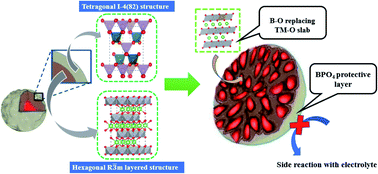High Ni–low Co layered oxides are considered as the most promising next generation cathode materials for high energy density lithium ion batteries in order to fulfil the demand of 300 miles of driving range per charge, longer service life and cost-effectiveness for their application in electric vehicles (EVs). However, a low content of Co and Mn leads to mechanical damage, chemical instability and structural degradation. Herein, single and dual modification is investigated on high Ni–low Co LiNi0.94Co0.03Mn0.03O2 (NCM94) by boron doping and boron orthophosphate (BPO4) surface coating via a wet chemical strategy. Boron doping can effectively mitigate the anisotropic stress by suppressing the H2–H3 phase transition, reduce the generation of microcracks and further enhance the electrochemical kinetics owing to the strong B–O bond. Moreover, since BPO4 is a good ionic conductor, as a surface coating it can reduce electrolytic erosion of the layered oxide cathode material as well as facilitate Li+ diffusion. Therefore, the dual modified sample delivers a discharge capacity of 255 mA h g−1 at 0.1C and exhibits an outstanding capacity retention of 91% at 0.5C after 100 cycles while unmodified NCM94 can only retain 66.17% of its initial discharge capacity. In addition, B-NCM@BP exhibits superior rate performance at a high C-rate (10C). As a consequence, the dual modification strategy effectively protects the particle core as well as the surface which may help to deliver high discharge capacity along with improved cycling stability for the application of high Ni low Co cathodes in EVs.

